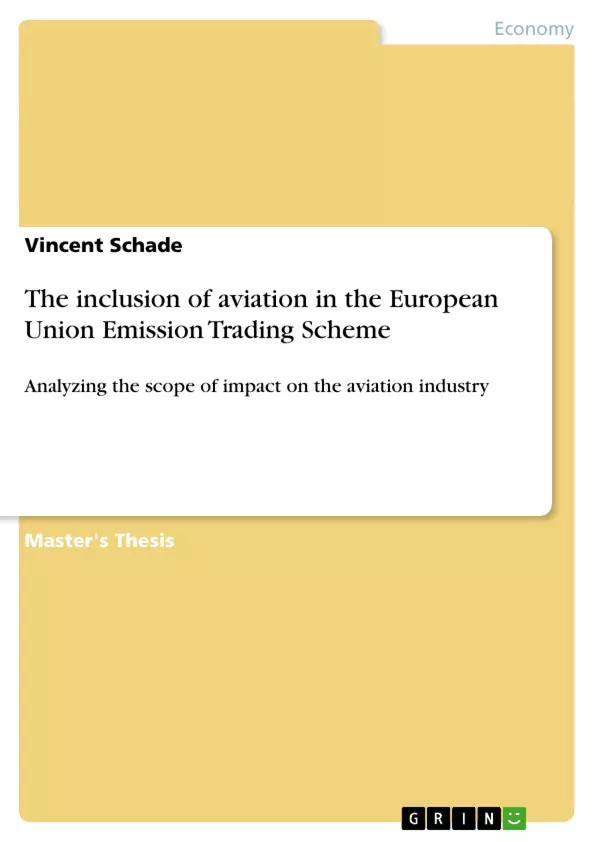A significant volume of literature already exists concerning the inclusion of aviation in the EU-ETS. Most of the research laid its focus on specific industry levels such as the individual airline, the aviation industry in general or macroeconomic aspects. In this context, these studies tried to anticipate market reactions triggered by the EU-ETS by analyzing specific issues such as the financial impact on airlines, changes in competitive behavior or implications for the overall industry development. As a consequence, the existing studies took only a limited market view and made assumptions about expected developments in specific fields of the aviation industry. However, at the time of writing this thesis, conclusions about the scope of impact could hardly be drawn from existing impact assessments because of the wide range of issues that exceeded the scope of most impact studies. Hence, a broader research approach is needed which takes different analytical perspectives to describe the scope of impact of the EU-ETS and depict potential effects for the aviation industry.
Inhaltsverzeichnis (Table of Contents)
- Introduction
- Background
- Objective and limitations
- Structure
- Legal framework for climate change and emission trading
- Demarcation of international and EU law for climate change
- United Nations Framework Convention on Climate Change
- Kyoto Protocol
- European Union Emission Trading Scheme
- Motivation and objectives
- Scope and extensions
- Allocation and cap system
- Trading and price mechanisms
- Timeline and structural changes
- International aviation and climate change
- International aviation industry and airline economics
- Market evolution and competition
- Market players
- Price and demand mechanisms
- Industry trends
- Environmental policies in civil aviation
- Convention on International Civil Aviation
- Aviation Directive
- Motivation and objectives
- Major design elements
- Current issues in climate policy for international aviation
- Impact analysis of the EU-ETS on the aviation industry
- Focus of analysis and research approach
- Airline profitability
- EU-ETS costs
- Pricing behavior
- Windfall profits
- Industry competition
- Distributional effects of allowance allocation
- Airline type
- European versus non-European airlines
- Industry performance and development
- Technological advancement
- Operational improvement
- Volume measures and modal shift
- Analysis results and management implications
Zielsetzung und Themenschwerpunkte (Objectives and Key Themes)
This thesis analyzes the scope of impact the European Union Emission Trading Scheme (EU-ETS) has on the aviation industry. It aims to explore the legal framework for climate change and emission trading, particularly focusing on the EU-ETS, and examine its implications for airline profitability, industry competition, and overall performance.- The impact of the EU-ETS on airline profitability, including cost implications, pricing behavior, and potential windfall profits.
- The influence of the EU-ETS on industry competition, considering the distribution of allowance allocation, the impact on different airline types, and the comparison between European and non-European airlines.
- The impact of the EU-ETS on industry performance and development, examining the role of technological advancement, operational improvement, and changes in volume measures and modal shift.
- The legal framework for climate change and emission trading, with a focus on the EU-ETS and its design elements, motivation, and objectives.
- The environmental policies in civil aviation, including the Convention on International Civil Aviation and the Aviation Directive, exploring their relevance in the context of climate change mitigation.
Zusammenfassung der Kapitel (Chapter Summaries)
- Chapter 1 introduces the topic of the EU-ETS's impact on the aviation industry. It outlines the background, objectives, and limitations of the study, and provides a structure for the subsequent chapters.
- Chapter 2 examines the legal framework for climate change and emission trading, focusing on the EU-ETS. It covers the international and EU legal frameworks, the Kyoto Protocol, and the EU-ETS's design, objectives, and timeline.
- Chapter 3 explores the international aviation industry and its relationship with climate change. It examines the industry's evolution, market players, price and demand mechanisms, and relevant environmental policies.
- Chapter 4 analyzes the impact of the EU-ETS on the aviation industry. It explores the study's approach, examines the impact on airline profitability, industry competition, and industry performance and development.
Schlüsselwörter (Keywords)
This thesis focuses on the impact of the European Union Emission Trading Scheme (EU-ETS) on the aviation industry. It examines the legal framework for climate change and emission trading, specifically the EU-ETS, analyzing its implications for airline profitability, industry competition, and industry performance. Key concepts include airline economics, environmental policies in civil aviation, the Kyoto Protocol, and the EU-ETS's design elements, objectives, and impact on industry stakeholders.- Quote paper
- Vincent Schade (Author), 2013, The inclusion of aviation in the European Union Emission Trading Scheme, Munich, GRIN Verlag, https://www.grin.com/document/231173



